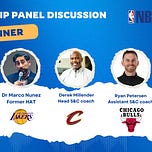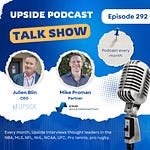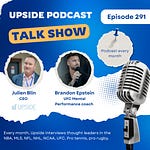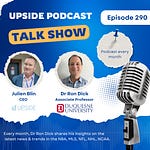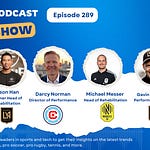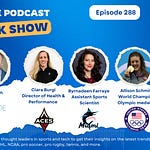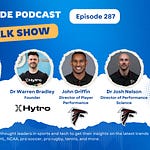This week we have the honor to interview again a group of NBA sports performance executives to talk about the latest trends in the world of sports performance and rehabilitation.
Dr Marco Nunez, the former head athletic trainer for the LA Lakers (NBA).
Derek Millender, the head S&C coach for the Cleveland Cavaliers (NBA).
Ryan Petersen, the assistant S&C coach for the Chicago Bulls (NBA).
Here are the topics that we covered during the video interview:
Q1. Life after the NBA: “From your experience, how do you successfully transition from an NBA team settings to having your own practice outside of the NBA? What are the best practices there?”
Q2. Technology adoption: “How do you evaluate when it’s the right time to implement a new technology, and what are the key factors that determine whether it actually adds value in an NBA setting and how long does it typically take to integrate and adopt a new technology into the workflow?”
Q3. Leveraging diverse expertise: “NBA teams now include specialists from a wide range of backgrounds—performance science, data analytics, psychology, and more. What’s the best way to integrate these perspectives so they enhance, rather than compete with, each other, and best collaborate during tough conversations?”
Q4. Performance optimization: “With the intensity of the NBA schedule, what are the most effective approaches you’ve seen to maintain peak performance throughout an 82-game season and playoffs?”
You can watch the video interview below by clicking on the Youtube link. You can also listen to the audio interview by clicking on the link at the top of the page:
Here are some of the best quotes of our conversation with Marco, Derek, and Ryan:
Q1. Life after the NBA
Marco Nuñez:
“When I first left the Lakers and started my own practice, I was reluctant to use my NBA credibility. I thought it might come off the wrong way, until someone told me, ‘You’ve got to use that—people want that experience.’ And it’s true. Clients—whether they’re athletes or weekend warriors—want to be treated like pros. The value isn’t just in what you do, but in knowing which ‘screw to turn,’ like in that old story about the engineer who charged $15,000 for knowing where to make a single adjustment. That’s what our experience at the NBA level gives us. Transitioning means you also have to hustle—learn marketing, business, even entrepreneurship—things we’re not taught in athletic training or strength programs. You have to decide whether you’re going for scale, like training a large pool of athletes, or the VIP concierge model where you work with fewer clients but give them full access. Either way, you need to lean into the credibility you earned.”
Derek Millender:
“It’s not easy for NBA coaches and trainers to think about life after the league, because we’ve worked so hard to get here. But the reality is—it’s not if, it’s when. At some point, this ends. That doesn’t mean you’re not professional or capable, it just means change is inevitable. So you need to start preparing while you’re still in it. Do you want to open your own facility, consult, or join forces with others? It’s about being proactive rather than waiting until you’re out and asking, ‘Now what?’ I think the biggest mindset shift is realizing that planning for what comes next is not a weakness—it’s a necessity.”
Ryan Petersen:
“I actually went the other way—I started in private practice and then came into the NBA. Running my own clinic taught me hard lessons in marketing, operations, and entrepreneurship. None of that was taught in PT school, so I learned by making mistakes. That perspective helps me know what the transition back might look like when my NBA career ends. I think it’s similar to players—many of them have no plan after basketball because they’ve been locked in for 20 years. For us as practitioners, we need to avoid the same trap. Having that foresight and being honest with yourself is key. Otherwise, you wake up one day and it feels like the dream just ended with no plan for what’s next.”
Q2. Technology Adoption
Derek Millender:
“The process for us is collaborative. It might start with a strength coach, an AT, or a dietitian who identifies a need. Then we research devices—look at scientific reviews, talk to peers, test them—and bring it to our high-performance group. From there, it’s about alignment. Even if the strength staff champions it, we want the PTs, ATs, and coaches to see how it adds value for them too. If it only helps one department, adoption stalls. When it works, it’s a slow burn. Year one, maybe you only use a device for one or two things even though it has 20 features. Over time, as comfort builds, usage grows. But that’s the reality—it takes at least a full season before technology really integrates. And if you swing and miss on a $30,000 purchase, it’s much harder to get buy-in the next time.”
Ryan Petersen:
“It starts with vision. If a piece of tech doesn’t align with your team’s philosophy, it’s wasted time and money no matter how good it is. The other big factor is friction. If a device is complicated, players won’t buy in and staff won’t use it consistently. I’d rather have a tool that does one or two things very well, with almost no friction, than something that claims to do everything but slows us down. For me, the best way to learn is hands-on—I’ll test it myself, do hundreds of reps, make mistakes—so I can teach athletes and staff with confidence. The easier it is to use daily, the more likely it’s going to stick.”
Marco Nuñez:
“I think it takes at least one full year to truly evaluate whether a new technology makes a difference. You can’t just test it in pre-season and assume it works. And the decision has to come from the inside out: what are our biggest injury risks or performance gaps? Then you look outward and see which tools might help solve those problems. You also need the staff bandwidth to use it properly. Sometimes there’s pressure—if another team wins a championship using a certain device, front offices start asking why we don’t have it. But just because it worked for them doesn’t mean it fits your environment. The real question is: does it make sense for us, right now?”
Q3. Leveraging Diverse Expertise
Derek Millender:
“Working across disciplines starts with relationships. You need to know the person before you can handle tough conversations with them. It might be grabbing dinner on the road, talking about music, family, or hobbies—something human. Once that trust is built, disagreements aren’t personal anymore. And you learn to recognize stress in each other, whether it’s someone eating more sweets during a losing streak or someone working out extra to cope. That’s when you step in with support, even small things like grabbing their favorite coffee. Those personal deposits make it easier to collaborate when pressure hits. At the end of the day, if everyone remembers we’re here for the players, it keeps us aligned.”
Ryan Petersen:
“I think humility and curiosity are the two most important qualities. If you walk into a room full of experts trying to prove how much you know, it doesn’t work. If you walk in genuinely curious, willing to learn, and clear that the goal is the player, then collaboration becomes natural. Some of the best meetings I’ve been in are when everyone—from PTs to data scientists to coaches—shares their piece of the puzzle, and you come away with a plan that reflects all perspectives. That only works if people check their egos and actually listen. It sounds simple, but it changes the whole dynamic.”
Q4. Performance Optimization
Derek Millender:
“The best systems I’ve seen are collective. Performance optimization isn’t about one department—it’s constant communication between strength, medical, nutrition, sports science, and coaching. It’s about stitching together all those small conversations—what the dietitian heard at breakfast, what the PT saw in treatment, what the coach noticed in practice—so the full picture of the athlete emerges. Data matters, but so does context. Maybe the force plate says one thing, but you know he’s dealing with family stress or a nagging issue. That blend of science and art—reading both the numbers and the person—is how you sustain performance over 82 games.”
Ryan Petersen:
“What stands out to me is how consistent the veterans are. The players who last 10, 15, 20 years all have simple, rock-solid habits—sleep, nutrition, warm-up, recovery—that they do every single day. It’s like brushing your teeth. Those habits don’t look flashy, but they compound over time. For younger players, one of the greatest gifts we can give them is exposure—let them try things, make mistakes, and eventually build their own routine. Because when the season gets hard—when they’re not playing well or not playing at all—that routine becomes their anchor. It gives them something they control in a world where so much is out of their hands.”
You may also like:
🔥Upside Chat with Chris Chase (Memphis Grizzlies/NBA), Dr Marco Nunez (ex LA Lakers/NBA), Dr Andy Barr (Quantum Performance), Derek Millender (Cleveland Cavaliers /NBA).
This week we have the honor to interview again a group of NBA sports performance executives:
🔥Upside NHL Group Chat with Alexi Pianosi (Colorado Avalanche), Chris Stackpole (NJ Devils), Adam Douglas (Penguins)
This week we have the honor to interview a group of NHL sports performance executives to talk about the latest trends in the world of sports performance, load management, sleep/recovery management, rehabilitation and data & wearable tech integration, and mental performance in the NHL.
🔥Upside NFL Group Chat with Ted Rath (New Orleans Saints), Roderick Moore Jr (Pittsburgh Steelers), Ryan Juarez (Washington Commanders)
This week we have the honor to interview a group of NFL sports performance executives to talk about the latest trends in the world of sports performance, load management, sleep/recovery management, rehabilitation and data & wearable tech integration, and mental performance in the NFL.

